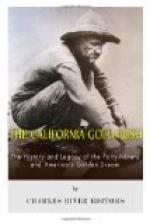But these bar-rooms were a totally different institution from the gambling resorts. Although gambling was not now considered the entirely worthy occupation of a few years previous, and although some of the better citizens, while frequenting the gambling halls, still preferred to do their own playing in semi-private, the picturesqueness and glory of these places had not yet been dimmed by any general popular disapproval. The gambling halls were not only places to risk one’s fortune, but they were also a sort of evening club. They usually supported a raised stage with footlights, a negro minstrel troop, or a singer or so. On one side elaborate bars of rosewood or mahogany ran the entire length, backed by big mirrors of French plate. The whole of the very large main floor was heavily carpeted. Down the center generally ran two rows of gambling tables offering various games such as faro, keeno, roulette, poker, and the dice games. Beyond these tables, on the opposite side of the room from the bar, were the lounging quarters, with small tables, large easy-chairs, settees, and fireplaces. Decoration was of the most ornate. The ceilings and walls were generally white with a great deal of gilt. All classes of people frequented these places and were welcomed there. Some were dressed in the height of fashion, and some wore the roughest sort of miners’ clothes—floppy old slouch hats, flannel shirts, boots to which the dried mud was clinging or from which it fell to the rich carpet. All were considered on an equal plane. The professional gamblers came to represent a type of their own,—weary, indifferent, pale, cool men, who had not only to keep track of the game and the bets, but also to assure control over the crowd about them. Often in these places immense sums were lost or won; often in these places occurred crimes of shooting and stabbing; but also into these places came many men who rarely drank or gambled at all. They assembled to enjoy each other’s company, the brightness, the music, and the sociable warmth.




